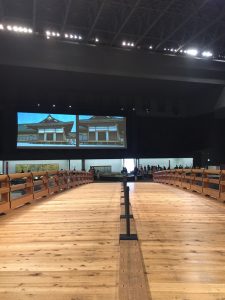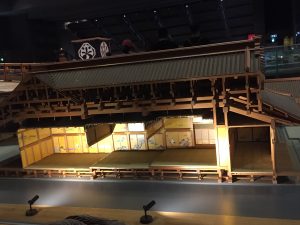In the early summer hotness, we took the full train with サラリーマン for half an hour and met Aridome-Sensei’s sister at Ebisu Station, from which we headed to Dr. Qiu’s Kanpo clinic. The clinic first impressed me as a very cultured space, with all the glass containers with herbs and wooden tables and decorations, giving a sense of rituality. And indeed, as Kanpo is all about recovering the balance of the body, boosting 気, and seeking a harmonious relationship between the body and the environment, one could view it as a ritual of purifying, or liberating, the body.
Dr. Qiu is incredibly insightful and articulate, and I really appreciate that she was trying to make Kanpo understandable and relatable instead of mystifying and elevating it. It was very enjoyable to listen to her, and in the room, I could feel an energy flowing that bonded everyone together and relating us to her sharing. Although my previous knowledge of traditional Chinese medicine helped with understanding all the concepts and ideas Dr. Qiu talked about, it was very interesting to hear about her experience practicing Kanpo in different countries. Her example of giving a 強い prescription and 優しい prescription to people of different constitutions (体質) and body build showed that Kanpo was really individual-based and that the treatment heavily relies on the Kanpo doctor to keep a long-term contact with the patient. Dr. Qiu gave examples of treating women with breast cancer but also want to be pregnant to speak to how Kanpo works, and this part was new to me. If thinking about the hormone level, as the Western medicine would do, treating breast cancer and helping a woman have a baby are contradictory since an increasing hormone level to cause breast cancer to deteriorate while to get pregnant a high level of hormone is required. She approached the issue by attacking the core problem that caused both illnesses. From the perspective of Kanpo, both breast cancer and difficulty to get pregnant are results of 瘀血, or blood stasis, which means that the blood flow in the body is thwarted. The treatment Dr. Qiu did was to boost 気 and give prescriptions to make blood flow easily. And after three years a patient successfully got pregnant at the age of 38.
Her incredible explanation and stories were fascinating and relatable. The holistic view of the body and the focus on the interactions of the body and the environment require that Kanpo is not just medicine but a lifestyle since treating from a holistic view requires living thinking holistically about the body.
After lunch at Ebisu, we “traveled” to Edo-Tokyo Museum, with an incredible design and exhibition of Edo-era and modern Tokyo.  This is Nihonbashi (the bridge of Japan), through which people could enter Tokyo during Edo-era. In the museum, Nihonbashi divides the exhibition into Edo-era and modern Tokyo areas and also connects the audience to the heart of Tokyo since we had to walk through the bridge to enter Edo.
This is Nihonbashi (the bridge of Japan), through which people could enter Tokyo during Edo-era. In the museum, Nihonbashi divides the exhibition into Edo-era and modern Tokyo areas and also connects the audience to the heart of Tokyo since we had to walk through the bridge to enter Edo.
 There were incredibly delicate models of Edo-era buildings, among which this Kabuki house impressed me most. The Kabuki house is a manifestation of Shogun’s power and status. The different levels of the floor were suited for people of different political status in the shogunate, and the little door on the highest level was an emergency exit for the shogun if anything happens. The Edo-era exhibition opened up my mind about Japanese history and the part about how the shogun balanced the power of local daimyōs by having them living in Edo for one year every three years and keeping their family in Edo.
There were incredibly delicate models of Edo-era buildings, among which this Kabuki house impressed me most. The Kabuki house is a manifestation of Shogun’s power and status. The different levels of the floor were suited for people of different political status in the shogunate, and the little door on the highest level was an emergency exit for the shogun if anything happens. The Edo-era exhibition opened up my mind about Japanese history and the part about how the shogun balanced the power of local daimyōs by having them living in Edo for one year every three years and keeping their family in Edo.
This was also my first time really thinking about a museum/exhibition politically. As suggested by the reading, the Edo-era exhibition idealizes the working class while completely ignoring the fact that people in the working class encounter all kinds of difficulties and the riots they started. This observation was definitely true in the museum, since the image of the working class in Edo-era was shown as hardworking and living in harmony, through the vivid house models and delicate interactive facilities. However, the gender factor was absent in the Edo exhibition, while in the modern Tokyo section, the exhibits were mostly clearly gendered, the advertisement for women’s beauty products, for example. When I was talking with Prof. Selinger about the gender factor, she brought up an interesting question: why does the museum choose school girl uniform to represent the 1990s? She brought up an argument that since the economy started to go down in late 1980s, the industry targeted at young girls as consumers and commercializing school uniforms might work. I think that while school girls became the consumers, they were also consumed as a collective, considering that school uniforms could mean the main character of commercials would shift from women to teenage girls, and that school uniforms wiped out the individuality, making the girls vulnerable to the consumption of Shōjo, which emerged later.
